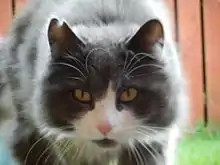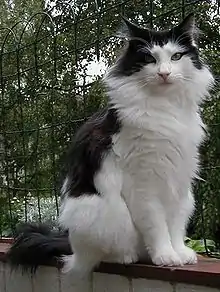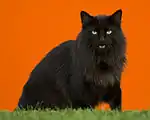Norwegian Forest cat
The Norwegian Forest cat (Norwegian: Norsk skogkatt or Norsk skaukatt) is a breed of domestic cat originating in Northern Europe.[1] This natural breed is adapted to a very cold climate, with a top coat of glossy, long, water-shedding hair and a woolly undercoat for insulation. Although this is uncertain, the breed's ancestors may have been a landrace of short-haired cats brought to Norway by the Vikings around 1000 AD, who may also have brought with them long-haired cats, like those ancestral to the modern Siberian and Turkish Angora. During World War II, the breed became nearly extinct until efforts by the Norwegian Forest Cat Club helped the breed by creating an official breeding program. It was registered as a breed with the European Fédération Internationale Féline in the 1970s, when a local cat fancier, Carl-Fredrik Nordane, took notice of the breed and made efforts to register it. Currently, the Norwegian Forest breed is very popular in Norway, Denmark, Sweden, Iceland and France.
| Norwegian Forest cat | |
|---|---|
_(cropped).jpg.webp) Norwegian forest cat in the snow | |
| Common nicknames | skogkatt |
| Origin | Norway |
| Breed standards | |
| CFA | standard |
| FIFe | standard |
| TICA | standard |
| WCF | standard |
| ACF | standard |
| ACFA/CAA | standard |
| CCA-AFC | standard |
| GCCF | standard |
| Domestic cat (Felis catus) | |
It is a big, strong cat, similar to the Maine Coon breed, with long legs, a bushy tail and a sturdy body. The breed is very good at climbing, since they have strong claws. The lifespan is usually 14 to 16 years, though kidney and heart diseases have been reported in the breed. Specifically in this breed, complex rearrangements of glycogen branching enzyme (GBE1) can cause a perinatal hypoglycaemic collapse and a late-juvenile-onset neuromuscular degeneration in glycogen storage disease type IV.

History
The Norwegian Forest cat is adapted to survive Norway's cold weather.[2][3] Its ancestors may include black and white shorthair cats brought to Norway from Great Britain some time after 1000 AD by the Vikings, and longhaired cats brought to Norway by Crusaders. These cats could have reproduced with farm and feral stock and may have eventually evolved into the modern-day Norwegian Forest breed.[4][5][6] The Siberian and the Turkish Angora, longhaired cats from Russia and Turkey, respectively, are also possible ancestors of the breed.[4] Norse legends refer to the skogkatt as a "mountain-dwelling fairy cat with an ability to climb sheer rock faces that other cats could not manage."[7] Since the Norwegian Forest cat is a very adept climber,[8][9] author Claire Bessant believes that the skogkatt folktale could be about the ancestor of the modern Norwegian Forest breed.[7] The name Norse skogkatt is used by some breeders and fancier organisations for the modern breed.
Most likely the ancestors of the Norwegian Forest cat served as ships' cats (mousers) on Viking ships.[10] The original landrace lived in the Norwegian forests for many centuries, but were later prized for their hunting skills and were used on Norwegian farms,[11] until they were discovered in the early twentieth century by cat enthusiasts.[12]
In 1938 the first organisation devoted to the breed, the Norwegian Forest Cat Club, was formed in Oslo, Norway.[13] The club's movement to preserve the breed was interrupted by World War II. Owing to cross-breeding with free-ranging domestic cats during the war, the Norwegian Forest cat became endangered and nearly extinct until the Norwegian Forest Cat Club helped the breed make a comeback by developing an official breeding program.[14][15] In the 1950s, King Olav V declared them the official cat of Norway.[16] Since the cat did not leave Norway until the 1970s, it was not registered as a breed in the Fédération Internationale Féline (FIFe), the pan-European federation of cat registries, until Carl-Fredrik Nordane, a Norwegian cat fancier, took notice of the breed, and made efforts to register it.[13] The breed was registered in Europe by the 1970s, and in the American Cat Fanciers Association in 1994.[17] In 1978, it was recognized in Sweden as an official breed,[18] and in 1989, they were accepted as a breed in the United Kingdom by the Norwegian Cat Club of Britain.[19]
The Norwegian Forest breed is very popular in Norway and Sweden. Since 2003, it has been the fifth most popular cat breed in France, where there are about 400 to 500 births per year.[20][21][22]
Breed description
The Norwegian Forest cat is strongly built and larger than an average cat. Adult females of this breed will typically weigh 3.6 – 8 kg (8 - 18 lbs), while males tend to weigh 4.5 to 9 kg (10 - 20 lbs). The breed has a long, sturdy body, long legs and a bushy tail. The coat consists of a long, glossy, thick and water-repellent top layer and a woolly undercoat and is thickest at the legs, chest and head.[7] The profile of the breed is generally straight.[10] Their water-resistant coat with a dense undercoat developed to help the cat survive in the harsh Scandinavian climate.[23]

The head is long with an overall shape similar to an equilateral triangle, a strong chin, and a muzzle of medium length; a square or round-shaped head is considered to be a defect.[24] The eyes are almond shaped and oblique, and may be of any colour.[7][25] The ears are large, wide at the base, and high set, have a tufted top, are placed in the extension of the triangle formed by the head, and end with a tuft of hair like the ears of the lynx.[24] All coat colors and divisions in the traditional, sepia and mink categories are accepted.[24] Since the cats have very strong claws, they are very good climbers, and can even climb rocks.[17]
Those cats that live primarily outdoors become swift and effective hunters, but the breed can also adapt to indoor life.[6] If bought from a registered breeder in the US, they tend to cost from $800 to $1500.[26] The cats usually live to be 14 to 16 years old.[26] As they are heavy-boned and tall, they eat more food than most other domestic breeds.[5][26]
Personality
They are friendly, intelligent, and generally good with people.[4] The Norwegian Forest cat has a lot of energy.[4] Although they are muscular, they tend not to do well with dogs and high-energy pets. They get easily afraid and do not like having high-energy pets around. They are very interactive cats who enjoy being part of their family environment and love to play games.[23]
Health issues
Kidney and heart diseases have been reported in the breed.[26] In an experiment directed by John C. Fyfea, Rebeccah L. Kurzhals, and others, it was concluded that a complex rearrangement in the breed's Glycogen branching enzyme (GBE1) can cause both a perinatal hypoglycemic collapse and a late-juvenile-onset neuromuscular degeneration in glycogen storage disease type IV in the breed.[27][28] This disorder, while rare, can prove fatal to cats that have it.[4] There are DNA tests available for GSD IV, and it is highly recommended (some cat associations obligate their Norwegian Forest cat breeder members) to carry out the DNA test before using such animals for breeding. PawPeds provide a pedigree database which comes together with health programmes, through publishing each single cat's test result, to provide useful information for breeders to make a well-informed breeding decision. The breed has also been known to suffer from hip dysplasia,[29] which is a rare, partially hereditary disease of the hip joint.[30]
Patella luxation is found more in the British Shorthair, Abyssinian and Devon Rex breeds, but it is recognized in Norwegian Forest cats as well. It is a condition in which patella moves out of its original physiological position.[31]
A pedigree with 871 Norwegian Forest cats show that familial cardiomyopathy in this breed.[32] There is also high prevalence of eosinophilic granuloma complex in Norwegian Forest cats which is suggestive of a genetic background.[33]
The main factors causing Toxoplasma gondii seropositivity on cats are age, raw meat and outdoor access. A study shows that T. gondii seropositivity varies by cat breeds. Norwegian Forest cats have a relatively high rate of Toxoplasma gondii seropositivity (4.66%) comparing with other pure-bred cats (Birman: 4.16%, British Shorthair: 3.39%, Korat: 2.03%, Ocicat: 4.26%, Siamese: 2.57%), but slightly lower than Persian cats (6.99%).[34]
Glycogen storage disease type IV due to branching enzyme deficiency was found in an inbred family of Norwegian forest cats.[35]
 |  | .JPG.webp) |  |
| 2 days | 1 week | 3 months | Full grown |
See also
References
- Association, Cat Fanciers. "Breed Profile: The Norwegian Forest Cat". cfa.org. Archived from the original on 2018-11-21. Retrieved 2017-09-25.
- "Accueil - chat norvegien - chat des forets norvegiennes" (in French). Kogkatt-norvegien.org. Retrieved 2011-03-05.
D'un aspect mi-chat, mi-lynx. Contrairement à d'autres races, le "Norvégien" n'est pas le résultat d'une reproduction planifiée mais la conséquence de l'évolution d'un chat placé dans des conditions de survie particulièrement difficiles: le rigoureux climat de la Norvège.
- Rousselet-Blanc, Pie (1992). Encyclopedie Active Le Cha. Larousse Kingfisher Chambers. p. 174. ISBN 2-03-517402-3.
- Richards, James (1999). ASPCA Complete Guide to Cats: Everything You Need to Know About Choosing and Caring for Your Pet. San Francisco: Chronicle Books. pp. 128–129. ISBN 978-0-8118-1929-9.
- Case, Linda (2003). The Cat: Its Behavior, Nutrition and Health (1 ed.). Ames, Iowa: Wiley-Blackwell. p. 26. ISBN 978-0-8138-0331-9.
- Taylor, David (1989). Ultimate Cat Book: A Unique Photographic Guide to More Than 100 International Breeds and Variations (1 ed.). New York City: Simon & Schuster. pp. 76–77. ISBN 978-0-671-68649-9.
- Bessant, Claire; Cutts, Paddy (1999). The Complete Guide to the Cat (Complete Animal Guides) (1 (US & CA) ed.). Hauppauge, New York: Barron's Educational Series. p. 181. ISBN 978-0-7641-5203-0.
- Caravan, Jill (1998). An Identification Guide to Cat Breeds. Hertfordshire: Eagle Editions. pp. 88–89. ISBN 978-1-902328-00-3.
- "Norwegian Forest Cat Breed Information". Vetstreet. Retrieved 2017-09-25.
- "Breed Profile: The Norwegian Forest Cat". Cat Fanciers' Association. Retrieved September 10, 2014.
- Furstinger, Nancy (2005). Norwegian Forest Cats. Edina, Minnesota: Abdo Publishing. p. 6. ISBN 978-1-59679-267-8.
- Duno, Steve (2008). Be the Cat: Secrets of the Natural Cat Owner. New York City: Sterling Publishing. p. 22. ISBN 978-1-4027-5278-0.
- "Lost Woods Norwegian Forest Cats". 2009. Retrieved 10 September 2014.
- Richards, Dorothy Silkstone (1996). Cat: Selection, Care, Training, Nutrition, Health, Breeding, Showing (2 ed.). London: Salamander Books. p. 56. ISBN 978-0-86101-703-4.
- Carolyn M. Vella; Lorraine M. Shelton; John J. McGonagle; Terry W. Stanglein (1999). Robinson's Genetics for Cat Breeders and Veterinarians (Hardcover) (4th ed.). Oxford: Butterworth–Heinemann. pp. xi–xii. ISBN 978-0-7506-4069-5.
- Diaz, Roman (2015). Origami Chess: Cats Vs. Dogs. Thunder Bay Press. ISBN 978-1626861718.
- Kristen Hampshire; Iris Bass; Lori Paximadis (2009). Cat Lover's Daily Companion: 365 Days of Insight and Guidance for Living a Joyful Life with Your Cat (1 ed.). Beverly, Mass.: Quarry Books. ISBN 978-1-59253-591-0.
- "Kattförbundet Sverak" Archived 2009-04-15 at the Wayback Machine (in French). Sverak. Retrieved 2011-03-20.
- McGreevy, Paul (2002). Cats (Home Reference Library) (Hardcover). San Francisco: Fog City Press. p. 249. ISBN 978-1-876778-75-0.
- "Pour l'Angleterre" (in French). Aniwa.com. Archived from the original on 2011-02-23. Retrieved 2011-03-05.
- "Le Sphynx : Haut dans les cœurs du classement CFA" (in French). Aniwa. Retrieved 2010-12-06.
- "Bienvenue sur le site de l'Unité de Médecine de l'Elevage et du Sport de l'Ecole Nationale Vétérinaire d'Alfort". (in French). UMES. Retrieved 2011-03-12
- "Norwegian Forest Breed". tica.org. Retrieved 2020-02-05.
- Rousselet-Blanc, Pie (1992). Hardcover (ed.). Encyclopedie Active Le Chat (in French). New York City: Larousse Kingfisher Chambers. p. 175. ISBN 978-2-03-517402-4.
- Norwegian Forest Breed Standard Archived 2011-07-28 at the Wayback Machine. The International Cat Association. Published 1 May 2004. Accessed 26 March 2011.
- Burke, Don (2005). The Complete Burke's Backyard: The Ultimate Book of Fact Sheets. Millers Point, N.S.W.: Murdoch Books. p. 723. ISBN 1-74045-739-0.
- Fyfe, J. C.; Kurzhals, R. L.; Hawkins, M. G.; Wang, P.; Yuhki, N.; Giger, U.; Van Winkle, T. J.; Haskins, M. E.; Patterson, D. F.; Henthorn, P. S. (2007). "A complex rearrangement in GBE1 causes both perinatal hypoglycemic collapse and late-juvenile-onset neuromuscular degeneration in glycogen storage disease type IV of Norwegian forest cats". Molecular Genetics and Metabolism. 90 (4): 383–392. doi:10.1016/j.ymgme.2006.12.003. PMC 2063609. PMID 17257876. "Deficiency of glycogen branching enzyme (GBE) activity causes glycogen storage disease type IV (GSD IV), an autosomal recessive error of metabolism. Abnormal glycogen accumulates in myocytes, hepatocytes, and neurons, causing variably progressive, benign to lethal organ dysfunctions. A naturally occurring orthologue of human GSD IV was described previously in Norwegian Forest cats (NFC)."
- Eldredge, Debra; Carlson, Delbert DVM; Carlson, Liisa; Griffin, James (2007-12-10). Cat Owner's Home Veterinary Handbook, Fully Revised and Updated (3rd ed.). Howell Book House. p. 403. ISBN 978-0-470-09530-0.
- Eldredge, Debra (2003). "17: Preventative Health Care for Your Pet". Pills For Pets: The A to Z Guide to Drugs and Medications for Your Animal Companion. Citadel Press. p. 63. ISBN 978-0-8065-2436-8.
An example here is the Norwegian Forest cat. Dedicated owners learned that their cats have the possibility of suffering from hip dysplasia.
- Simon, John; Pederson, Stephanie (2000). What Your Cat Is Trying To Tell You (Mass Market Paperback) (1st ed.). St. Martin's Press. p. 168. ISBN 978-0-312-97288-2.
- Jenssen, Andrea. "Breeding traits and hereditary disorders of the Norwegian forest cat during breed development" (PDF). Cite journal requires
|journal=(help) - März, Imke; Wilkie, Lois J; Harrington, Norelene; Payne, Jessie R; Muzzi, Ruthnea A L; Häggström, Jens; Smith, Ken; Luis Fuentes, Virginia (2014-10-30). "Familial cardiomyopathy in Norwegian Forest cats". Journal of Feline Medicine and Surgery. 17 (8): 681–691. doi:10.1177/1098612x14553686. ISSN 1098-612X. PMID 25359788.
- Leistra, W. H. G.; Oost, B. A. van; Willemse, T. (2005-04-30). "Non-pruritic granuloma in Norwegian forest cats". Veterinary Record. 156 (18): 575–577. doi:10.1136/vr.156.18.575. ISSN 0042-4900. PMID 15866902.
- Must, Kärt; Hytönen, Marjo K.; Orro, Toomas; Lohi, Hannes; Jokelainen, Pikka (2017-09-08). Calderaro, Adriana (ed.). "Toxoplasma gondii seroprevalence varies by cat breed". PLOS One. 12 (9): e0184659. doi:10.1371/journal.pone.0184659. ISSN 1932-6203. PMC 5590984. PMID 28886182.
- Fyfe, John C.; Giger, Urs; Van Winkle, Thomas J.; Haskins, Mark E.; Steinberg, Sheldon A.; Wang, Ping; Patterson, Donald F. (December 1992). "Glycogen Storage Disease Type IV: Inherited Deficiency of Branching Enzyme Activity in Cats". Pediatric Research. 32 (6): 719–725. doi:10.1203/00006450-199212000-00020. ISSN 1530-0447. PMID 1337588.
External links
| Wikimedia Commons has media related to Norwegian Forest Cats. |
- Cat Fanciers' Association Breed Profile: Norwegian Forest Cat
- PawPeds Norwegian Forest cat pedigree database
- Standard description of Norwegian Forest cat with images and drawings - Bolboreta Forest Cattery
- Video of Norwegian Forest Cat History - Elvenstar Cattery